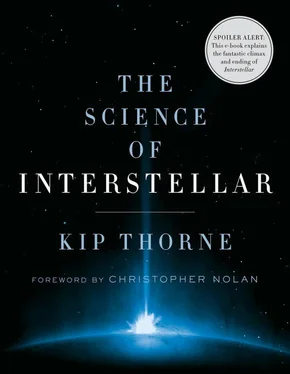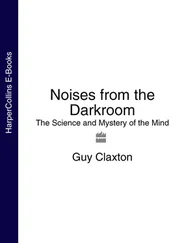Upon reaching the volcano’s rim, the Endurance , ideally, would travel around and around it, at constant speed. Because it moves neither inward nor outward, the inward pull of gravity on the rim must precisely be counterbalanced by the outward centrifugal force that arises from the ship’s fast circumferential motion.
This indeed is the case, as shown in Figure 27.6—an analog of the force balance plot for Miller’s planet (Figure 17.2). At the Endurance ’s critical orbit, the red curve (the inward gravitational pull on the Endurance ) and the blue curve (the outward centrifugal force) cross, so the two forces are in balance.
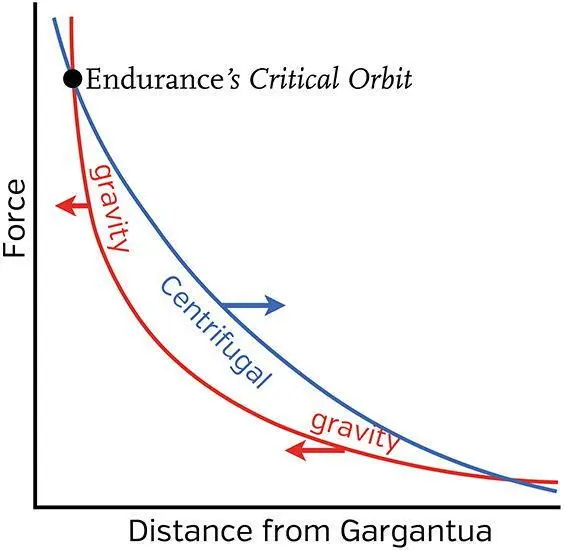
Fig. 27.6. The gravitational and centrifugal forces acting on the Endurance , and how they change with changing distance from Gargantua.
However, the balance is unstable, as our volcano-rim analogy suggests. [50] The agreement between our volcano-rim analogy and these force arguments is due to a key fact: The net force (gravitational plus centrifugal) on the Endurance is proportional to the slope of the energy surface (Figures 27.3 and 27.5). Can you figure out why?
If the Endurance is randomly pushed inward just a bit, then gravity overwhelms the centrifugal force (the red curve rises above the blue curve), so the Endurance is pulled on inward toward Gargantua’s horizon. If the Endurance is pushed outward just a bit, then the centrifugal force wins the battle with gravity (the blue curve is above the red curve), so the Endurance is pushed on outward, escaping Gargantua’s tight grip.
By contrast (as we saw in Chapter 17), on the orbit of Miller’s planet, the balance between the gravitational and centrifugal forces is stable.
Disaster on the Rim: Ejection of TARS and Cooper
In my science interpretation of the movie, the volcano’s rim is very narrow, so the critical orbit on the rim is exceedingly unstable. Tiny errors in navigation will send the Endurance careening down toward Gargantua (down into the volcano) or away from Gargantua (down toward the moat).
Errors are inevitable, so the Endurance ’s course must be corrected, continually, by a well-designed feedback system, like an automobile’s cruise control but much better.
In my interpretation, the feedback system is not quite good enough and the Endurance winds up dangerously far down the inside lip of the volcano. The Endurance must use all the thrust at its disposal to climb back up to the critical orbit.
But this is too subtle and technical for action-packed scenes and a hugely diverse audience, so Christopher Nolan chose a simpler, more in-your-face approach. No mention of instability. No mention of feedback. The Endurance simply plunges too close to Gargantua, and Cooper responds with all the thrust he can muster to climb back out and escape Gargantua’s grip.
The result is the same: lander 1, piloted by TARS, and Ranger 2, piloted by Cooper, fire their rockets while attached to the Endurance , pushing the Endurance back out of Gargantua’s gravitational grip. Then, to get the last possible kick, explosive bolts blow the Endurance apart from lander 1 and Ranger 2. The lander and Ranger go plunging downward toward Gargantua, carrying TARS and Cooper with them, and the Endurance is saved (Figures 27.7 and 27.8).
In the movie, there is a tragic, parting conversation between Brand and Cooper. Brand doesn’t understand why Cooper and TARS must accompany the lander and Ranger into the black hole. Cooper gives her a rather lame though poetic excuse: “Newton’s third law. The only way humans have ever figured out for getting somewhere is to leave something behind.”
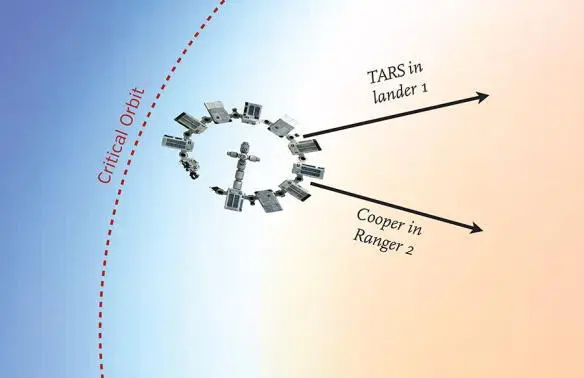
Fig. 27.7. The Endurance is thrown back up to the critical orbit by firing of rockets, followed by ejection of lander 1 and Ranger 2. [Image of the Endurance is from Interstellar .]
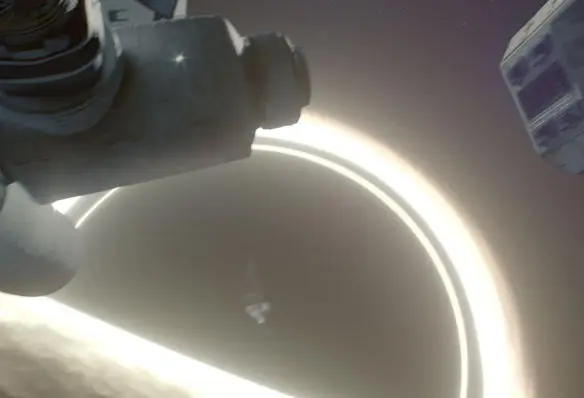
Fig. 27.8. Ranger 2 descending toward Gargantua, as seen by Brand in the Endurance , with portions of two Endurance modules in the foreground. The Ranger is the faintly seen object in the picture’s lower center, surrounded by Gargantua’s accretion disk. [From Interstellar , used courtesy of Warner Bros. Entertainment Inc.]
This surely is true. But the additional thrust on the Endurance , from Cooper and TARS accompanying the lander and Ranger into the hole, is awfully small. The greater truth, of course, is that Cooper wants to go into Gargantua. He hopes that he and TARS can learn the quantum gravity laws from a singularity inside Gargantua, and somehow transmit them back to Earth. It is his last, desperate hope for saving all of humanity.
The Endurance ’s Launch Toward Edmunds’ Planet
The critical orbit is an ideal spot for Brand and the robot Case to launch the Endurance in any desired direction, in particular, toward Edmunds’ planet.
How do they control their launch direction? Because the critical orbit is so unstable, a small rocket blast is sufficient to send the Endurance off it. And if the blast is ignited at precisely the right location along the critical orbit and has precisely the right strength, it will send the Endurance in precisely the desired direction (Figure 27.9).
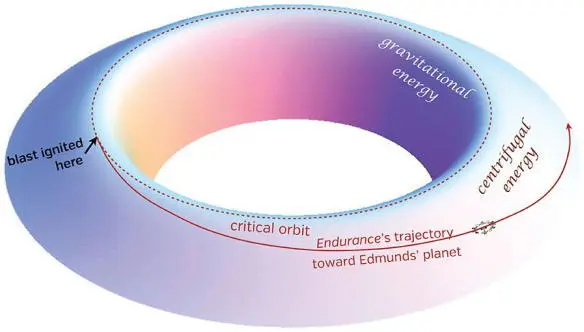
Fig. 27.9. The Endurance ’s trajectory off the critical orbit, toward Edmunds’ planet. [Image of the Endurance is from Interstellar .]
Actually, Figure 27.9 may leave you unconvinced that Brand and Case can launch in any direction they wish. That’s because it doesn’t capture the critical orbit’s three-dimensional structure. For that, see Figure 27.10.
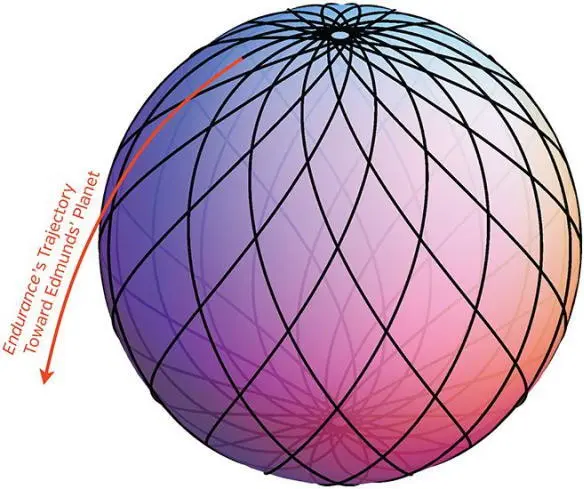
Fig. 27.10. A three-dimensional picture of the Endurance ’s critical orbit and its launch toward Edmunds’ planet. The critical orbit wraps around a sphere that surrounds Gargantua.
This convoluted critical orbit is a close analog of the trajectories of temporarily trapped light rays inside Gargantua’s shell of fire (Figures 6.5 and 8.2). Like those light rays, the Endurance is temporarily trapped when on its critical orbit. Unlike the light rays, the Endurance has a control system and rockets, so its launch off the critical orbit is in Brand’s and Case’s hands. And because of the orbit’s convoluted three-dimensional structure, the launch can be in any direction they wish.
But their launch leaves behind Cooper and TARS, plunging through Gargantua’s horizon. Plunging toward Gargantua’s singularities.
Some Personal History

Читать дальше
